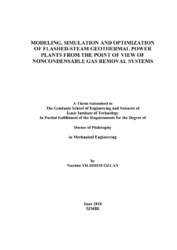Please use this identifier to cite or link to this item:
https://hdl.handle.net/11147/2938Full metadata record
| DC Field | Value | Language |
|---|---|---|
| dc.contributor.advisor | Gökçen Akkurt, Gülden | en |
| dc.contributor.author | Yıldırım Özcan, Nurdan | - |
| dc.date.accessioned | 2014-07-22T13:48:38Z | - |
| dc.date.available | 2014-07-22T13:48:38Z | - |
| dc.date.issued | 2010 | en |
| dc.identifier.uri | http://hdl.handle.net/11147/2938 | - |
| dc.description | Thesis (Doctoral)--Izmir Institute of Technology, Mechanical Engineering, Izmir, 2010 | en |
| dc.description | Includes bibliographical references (leaves: 143-152) | en |
| dc.description | xx, 157 leaves | en |
| dc.description.abstract | Geothermal fluids contain noncondensable gases (NCGs) at various amounts. The presence of NCGs in geothermal steam results with a dramatic decrease in net power output increasing condenser pressure and total auxiliary power consumption. Hence, NCGs should be withdrawn by a gas removal equipment to improve the performance of geothermal power plants (GPPs). The flashed-steam GPPs (single-flash, double-flash) are a relatively simple way to convert geothermal energy into electricity when the geothermal wells produce a mixture of steam and liquid. The primary aim of the Thesis is to model and develop a code to simulate flashed-steam GPPs to examine the thermodynamic and economical performance of NCG removal systems, which are major concerns at planning and basic design stages of GPPs. The model is validated comparing model output with Kizildere GPP output, classified as deterministic and static. The model is simulated to identify the effects of input variables which are NCG fraction, separator pressure, condenser pressure, wet bulb temperature, interest rate, tax rate, O&M cost ratio and electricity sales price. Among the variables, NCG fraction is the most significant parameter affecting thermodynamic performance and profitability of flashed-steam GPPs. The net power output and overall exergetic efficiency of singleflash GPP is decreased 0.4% for compressor system (CS), 2.2% for hybrid system (HS), 2.5% for reboiler system (RS) and 2.7% for steam jet ejector system (SJES) by 1% increase in NCG fraction. Based on thermodynamic and economical simulations, SJES, HS and CS can be recommended to be used for a NCG fraction range of 0-2%, 2-10% and >10%, respectively. Furthermore, thermodynamic performance of single-flash plants can be improved by adding second flash by 45.5-127.9%. | en |
| dc.language.iso | en | en_US |
| dc.publisher | Izmir Institute of Technology | en |
| dc.rights | info:eu-repo/semantics/openAccess | en_US |
| dc.subject.lcsh | Geothermal engineering | en |
| dc.subject.lcsh | Geothermal power plants | en |
| dc.title | Modeling, simulation and optimization of flashed-steam geothermal power plants from the point of view of noncondensable gas removal systems | en_US |
| dc.type | Doctoral Thesis | en_US |
| dc.department | Thesis (Doctoral)--İzmir Institute of Technology, Mechanical Engineering | en_US |
| dc.relation.publicationcategory | Tez | en_US |
| item.languageiso639-1 | en | - |
| item.fulltext | With Fulltext | - |
| item.openairecristype | http://purl.org/coar/resource_type/c_18cf | - |
| item.openairetype | Doctoral Thesis | - |
| item.grantfulltext | open | - |
| item.cerifentitytype | Publications | - |
| crisitem.author.dept | 03.10. Department of Mechanical Engineering | - |
| Appears in Collections: | Phd Degree / Doktora | |
Files in This Item:
| File | Description | Size | Format | |
|---|---|---|---|---|
| T000839.pdf | DoctoralThesis | 2.82 MB | Adobe PDF |  View/Open |
CORE Recommender
Page view(s)
294
checked on Jul 22, 2024
Download(s)
280
checked on Jul 22, 2024
Google ScholarTM
Check
Items in GCRIS Repository are protected by copyright, with all rights reserved, unless otherwise indicated.